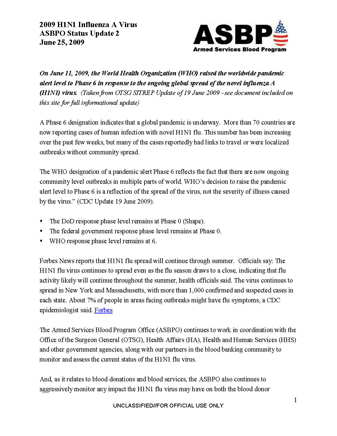 2009 H1N1 Influenza A Virus ASBPO Status Update 2
2009 H1N1 Influenza A Virus ASBPO Status Update 2
- 2 pages
- For Official Use Only
- June 25, 2009
On June 11, 2009, the World Health Organization (WHO) raised the worldwide pandemic alert level to Phase 6 in response to the ongoing global spread of the novel influenza A (H1N1) virus. (Taken from OTSG SITREP Update of 19 June 2009 –see document included on this site for full informational update)
A Phase 6 designation indicates that a global pandemic is underway. More than 70 countries are now reporting cases of human infection with novel H1N1 flu. This number has been increasing over the past few weeks, but many of the cases reportedly had links to travel or were localized outbreaks without community spread.
The WHO designation of a pandemic alert Phase 6 reflects the fact that there are now ongoing community level outbreaks in multiple parts of world. WHO’s decision to raise the pandemic alert level to Phase 6 is a reflection of the spread of the virus, not the severity of illness caused by the virus.” (CDC Update 19 June 2009).
- The DoD response phase level remains at Phase 0 (Shape).
- The federal government response phase level remains at Phase 0.
- WHO response phase level remains at 6.
Forbes News reports that H1N1 flu spread will continue through summer. Officials say: The H1N1 flu virus continues to spread even as the flu season draws to a close, indicating that flu activity likely will continue throughout the summer, health officials said. The virus continues to spread in New York and Massachusetts, with more than 1,000 confirmed and suspected cases in each state. About 7% of people in areas facing outbreaks might have flu symptoms, a CDC epidemiologist said. Forbes
The Armed Services Blood Program Office (ASBPO) continues to work in coordination with the Office of the Surgeon General (OTSG), Health Affairs (HA), Health and Human Services (HHS) and other government agencies, along with our partners in the blood banking community to monitor and assess the current status of the H1N1 flu virus.
And, as it relates to blood donations and blood services, the ASBPO also continues to aggressively monitor any impact the H1N1 flu virus may have on both the blood donor population and blood supply and will promptly communicate all information received along with recommended protocol.
Recommendations to mitigate risk for all publics, including government and military personnel are common hygiene protocols as follows: Cover your nose and mouth with a tissue when you cough or sneeze. Throw the tissue in the trash after you use it. Wash your hands often with soap and water, especially after you cough or sneeze. Alcohol-based hand cleaners are also effective. If you become ill with influenza-like symptoms, including fever, body aches, runny nose, sore throat, nausea, or vomiting or diarrhea, you may want to contact your health care provider, particularly if you are worried about your symptoms. Your health care provider will determine whether influenza testing or treatment is needed. If you get sick with influenza, the Centers for Disease Control and Prevention (CDC) recommends that you stay home from work or school and limit contact with others to keep from infecting them. Avoid touching your eyes, nose or mouth. Germs spread this way.
Recommend signs are posted with the above information in bathrooms, and common use areas.
